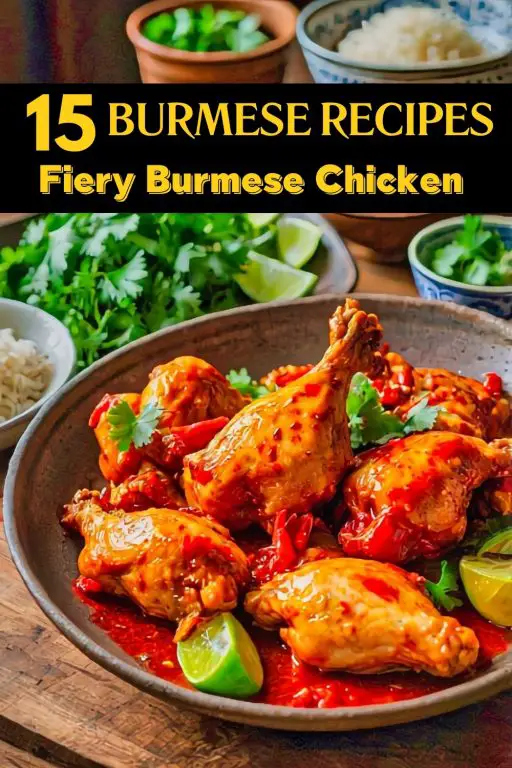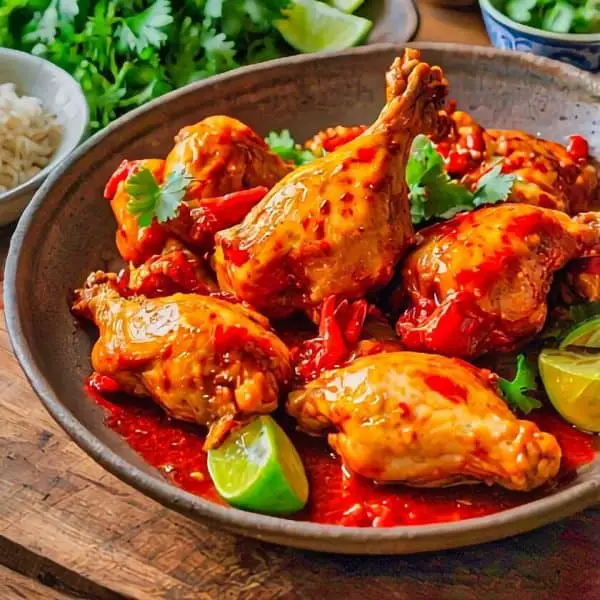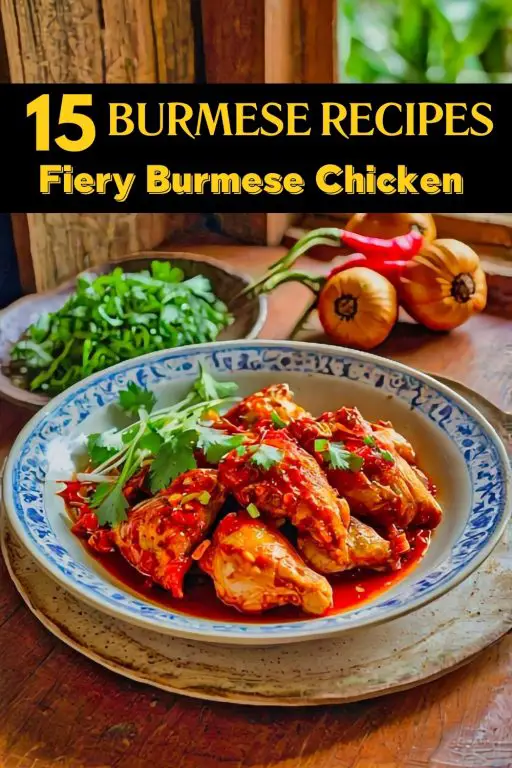I found the recipe for Fiery Burmese Chicken while on my food tour. This is a dish I had heard a lot about but had never tried. It was cool that night, and I learned that this dish is often served in Myanmar when it’s cooler outside. I was excited to try something new, and the dish’s spicy-warmth seemed right for the weather.
When we got to a small, family-run restaurant, we asked for the Fiery Burmese Chicken dish. The smell of the food was the first thing that caught my attention. It was spicy and rich, and it made my mouth water right away. The chicken was cooked over high heat, which made the outside crispy and the inside soft. I could see how the spices on the chicken gave it a bright red color. It was amazing how well the heat was balanced—it was strong but not too much.
I talked to some locals and learned that this dish is best enjoyed in the winter because the spices are picked at that time, making them extra fresh and tasty. It was a pleasant surprise that I was able to get the recipe after the meal. It was interesting to learn how much the quality of seasonal products affects how good a dish tastes.
One of the best parts of my food tour was trying the Fiery Burmese Chicken dish. It wasn’t just about the spice; it was about how the season, culture, and local products can bind a simple dish in a deep way. This taught me that even a dish that is very hot can bring more than just heat.

Ingredients For the Fiery Burmese Chicken Recipe
Skinless Chicken Breasts
Vegetable Oil
Finely Chopped Large Onion
Minced Garlic Cloves
Minced Ginger
Chili Powder
Turmeric
Cumin
Salt
Black Pepper
Chicken Broth
Tomato Paste
Fish Sauce
Lime Juice
Brown Sugar
Chopped cilantro
Thinly Sliced Scallions
Steamed Rice
Cooking Instructions For the Fiery Burmese Chicken Recipe
- Heat the oil in a large pot over medium-high heat. Add the onion and cook until softened, about 5 minutes.
- Add the garlic and ginger and cook for 1 minute more, stirring constantly.
- Add the chicken, chili powder, turmeric, cumin, salt, and black pepper. Cook until the chicken is browned on all sides, about 5-7 minutes.
- Add the chicken broth, tomato paste, fish sauce, lime juice, and brown sugar. Bring to a boil, then reduce the heat and simmer for 15-20 minutes, or until the chicken is cooked through and the sauce has thickened.
- Stir in the cilantro and scallions.6. Serve the Fiery Burmese Chicken with steamed rice.
 5 Essiential Ingredients for Cooking Burmese Style Food
5 Essiential Ingredients for Cooking Burmese Style Food
1. Rice
Description: Rice is the fundamental staple of Burmese cuisine, reflecting its status as a primary food source across Myanmar. It is typically long-grain or jasmine rice, known for its slightly sticky texture when cooked.
Usage: Rice accompanies nearly every meal, serving as the base for curries, soups, and salads. It is essential in dishes like Mohinga, where it is sometimes added directly to the soup or served on the side. In addition to steamed rice, fried rice variations are also popular, often including vegetables, meats, and sometimes even seafood. Rice is versatile, used in both everyday meals and festive dishes.
2. Fish Sauce (Ngan Pya Yay)
Description: Fish sauce is a fermented condiment made from fish and salt. It has a pungent aroma but imparts a deep umami flavour that is crucial to many Burmese dishes. It is usually made from anchovies or other small fish and aged to develop its robust taste.
Usage: Fish sauce is used extensively to season soups, curries, and salads. In dishes like Laphet (fermented tea leaf salad), it adds a salty depth that balances the tangy and bitter notes of the tea leaves. It is also a key ingredient in many dipping sauces and marinades, contributing to the complex flavour profiles typical of Burmese cuisine.
3. Lemongrass
Description: Lemongrass is a fragrant herb with a citrusy, slightly floral flavour. Its stalks are used in cooking, providing a bright, fresh aroma and taste. In Burmese cuisine, it is used both for its flavour and for its fragrant qualities.
Usage: Lemongrass is commonly added to broths and soups, such as Mohinga, to impart a distinctive lemony taste. It is also used in marinades for meat and fish, and in curries to enhance the overall flavour profile. Lemongrass is typically cut into pieces or bruised to release its essential oils, infusing dishes with its aromatic essence.
4. Ginger
Description: Ginger is a spicy, aromatic root widely used in Burmese cooking. It adds warmth and depth to dishes, with a flavour that is both sharp and sweet. Fresh ginger is preferred, though dried or powdered ginger is also used in some recipes.
Usage: Fresh ginger is often combined with garlic to form a flavour base for many Burmese dishes. It is used in curries, soups like Kaukswe (coconut noodle soup), and stir-fries. Ginger’s warming spice complements the complex flavours of Burmese cuisine, balancing out richer elements and enhancing the overall taste.
5. Turmeric
Description: Turmeric is a bright yellow spice known for its earthy, slightly bitter flavour and vibrant colour. It contains curcumin, which is responsible for its distinctive hue and is celebrated for its health benefits.
Usage: Turmeric is integral in many Burmese curries and stews, where it imparts a rich golden colour and an earthy flavour. It is often used in combination with other spices to create the complex flavour profiles typical of Burmese curries. Turmeric is also used in rice dishes and some soups to add both colour and flavour. Its presence is key to achieving the characteristic appearance and taste of traditional Burmese dishes.
Each of these ingredients plays a crucial role in defining the unique flavours of Burmese cuisine, contributing to the rich and varied taste experiences that characterise Myanmar’s culinary traditions.
5. Eating Healthy in Burma
Eating healthy in Burma, or Myanmar, is deeply intertwined with traditional dietary practices and a reliance on fresh, locally-sourced ingredients. The Burmese diet primarily revolves around rice, which serves as the staple component of most meals. This is typically accompanied by a variety of dishes that include vegetables, legumes, and lean proteins, reflecting a balanced approach to nutrition. Meals often feature an array of fresh vegetables such as leafy greens, beans, and squash, providing essential vitamins and minerals.
Burmese cuisine also incorporates a range of legumes and pulses, such as chickpeas and lentils, which are excellent sources of protein and fibre. Dishes like **Burmese chickpea salad** are not only nutritious but also showcase how traditional ingredients can be combined to create wholesome, satisfying meals. Additionally, seafood and lean meats are commonly used in curries and soups, contributing to a diet that includes a good balance of protein sources.
The use of herbs and spices, such as turmeric, ginger, and garlic, not only enhances flavour but also offers various health benefits. Turmeric, for example, contains curcumin, which is known for its anti-inflammatory properties. Similarly, garlic and ginger are known for their immune-boosting and digestive benefits.
Moreover, traditional Burmese meals often avoid excessive use of processed foods and sugars, focusing instead on whole, natural ingredients. This approach aligns with a healthy eating philosophy, promoting overall well-being. The traditional practice of using fresh ingredients and cooking methods such as steaming and boiling further supports a nutritious diet.
Overall, the emphasis on fresh produce, legumes, lean proteins, and beneficial spices in Burmese cuisine contributes to a balanced and health-conscious approach to eating. This traditional diet, rooted in local agricultural practices, offers a nutritious and satisfying way of eating that supports overall health and wellness.
FAQ For the Fiery Burmese Chicken Recipe
Q: What makes the Fiery Burmese Chicken recipe spicy?
A: The Fiery Burmese Chicken recipe gets its heat primarily from the use of dried red chilies, chili powder, or fresh green chilies, depending on the variation. These chilies are sautéed with onions, garlic, and ginger, creating a spicy, aromatic base. The heat is balanced by other ingredients such as turmeric and tomatoes, which add depth without overwhelming the palate. Adjusting the amount of chili used allows for customizing the spice level based on preference.
Q: Can the Fiery Burmese Chicken recipe be made less spicy?
A: Yes, the Fiery Burmese Chicken recipe can be toned down by reducing the amount of chili powder or fresh chilies used. You can also add more coconut milk or tomatoes to help mellow the heat while retaining the flavor of the dish. Another option is to remove the seeds from the chilies, which contain most of the heat. This way, the dish still has a bold flavor but with a more moderate spice level.
Q: What type of chicken is best for the Fiery Burmese Chicken recipe?
A: Bone-in chicken, such as thighs or drumsticks, is typically used in the Fiery Burmese Chicken recipe because it enhances the depth of flavor during slow cooking. The bones release additional richness into the spicy sauce as the dish simmers. However, boneless chicken can also be used if you prefer a quicker cooking time, though the sauce may be slightly less rich. Whether bone-in or boneless, the chicken absorbs the fiery spices well in both cases.
Q: What sides are traditionally served with the Fiery Burmese Chicken recipe?
A: The Fiery Burmese Chicken recipe is often served with steamed jasmine rice or sticky rice to balance the spiciness of the dish. Additional sides such as pickled vegetables or a fresh cucumber salad can also help cool down the heat. Some prefer pairing it with flatbreads like paratha to soak up the flavorful sauce. The combination of spicy chicken and cooling sides creates a well-rounded meal.
Q: How long does it take to cook the Fiery Burmese Chicken recipe?
A: Cooking the Fiery Burmese Chicken recipe typically takes about 45 minutes to an hour, depending on the cut of chicken used and the cooking method. The process includes marinating the chicken with spices, sautéing the aromatics, and then simmering everything together until the chicken is tender and the sauce thickens. Bone-in chicken may require slightly more time to cook through compared to boneless. However, the simmering time allows the flavors to meld beautifully into the dish.

Fiery Burmese Chicken
Equipment
- large mixing bowl
- Large skillet or wok
- Cutting board & Sharp knife
- Measuring cups and spoons
- whisk
- Small bowl for cornstarch slurry
- serving dish
Ingredients
- 2 lbs. boneless, skinless chicken breasts, cut into bite-sized pieces
- 2 tbsp vegetable oil
- 1 large onion, finely chopped
- 3 garlic cloves, minced
- 2 tsp ginger, minced
- 2 tsp chili powder
- 1 tsp turmeric
- 1 tsp cumin
- ½ tsp salt
- ½ tsp black pepper
- 2 cups chicken broth
- 1 tbsp tomato paste
- 2 tbsp fish sauce
- 2 tbsp ime juice
- 2 tbsp brown sugar
- ¼ cup cilantro, chopped
- ¼ cup scallions, thinly slice
- Steamed rice, for serving
Instructions
- Heat the oil in a large pot over medium-high heat. Add the onion and cook until softened, about 5 minutes.
- Add the garlic and ginger and cook for 1 minute more, stirring constantly.
- Add the chicken, chili powder, turmeric, cumin, salt, and black pepper. Cook until the chicken is browned on all sides, about 5-7 minutes.
- Add the chicken broth, tomato paste, fish sauce, lime juice, and brown sugar. Bring to a boil, then reduce the heat and simmer for 15-20 minutes, or until the chicken is cooked through and the sauce has thickened.
- Stir in the cilantro and scallions.6. Serve the Fiery Burmese Chicken with steamed rice.



3 comments
Every bite was packed with flavor. I’ll definitely be making this again.
I cant believe they didnt include the secret ingredient for that Fiery Burmese Chicken Recipe! Its the key to making it authentic. What a missed opportunity to elevate the dish.
I cant believe they didnt mention the secret ingredient for that Fiery Burmese Chicken recipe! Its like theyre holding out on us. What do you think it could be? Ghost peppers? Fish sauce? Intriguing…
Comments are closed.